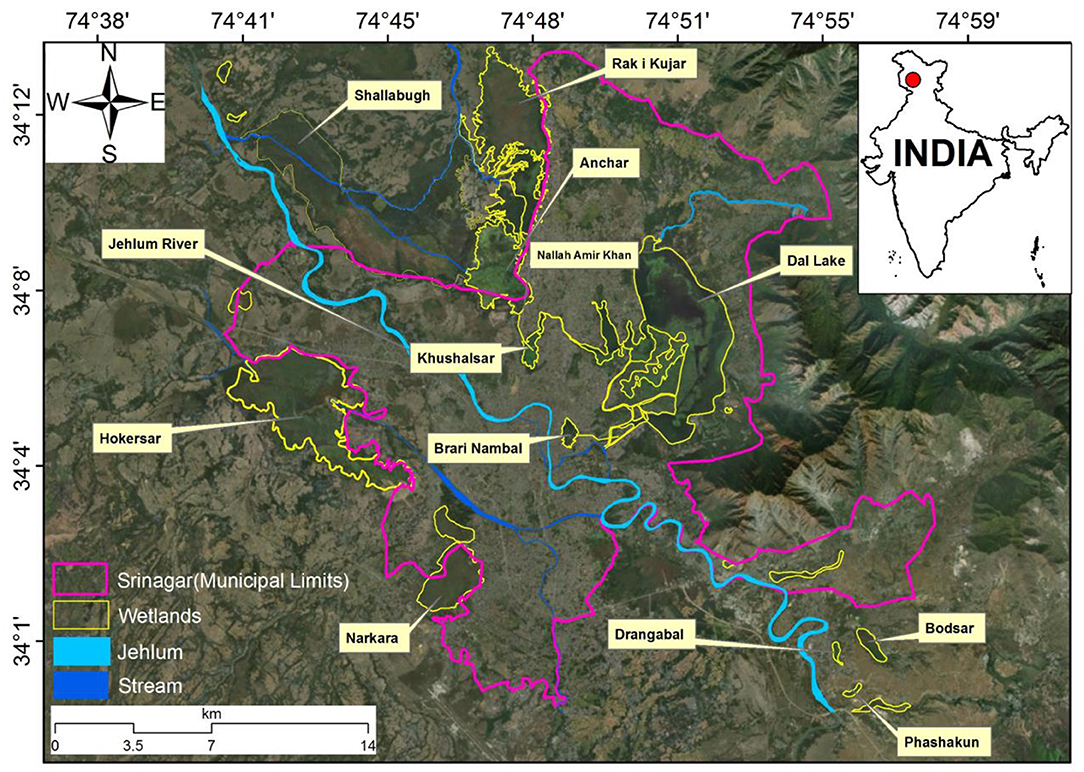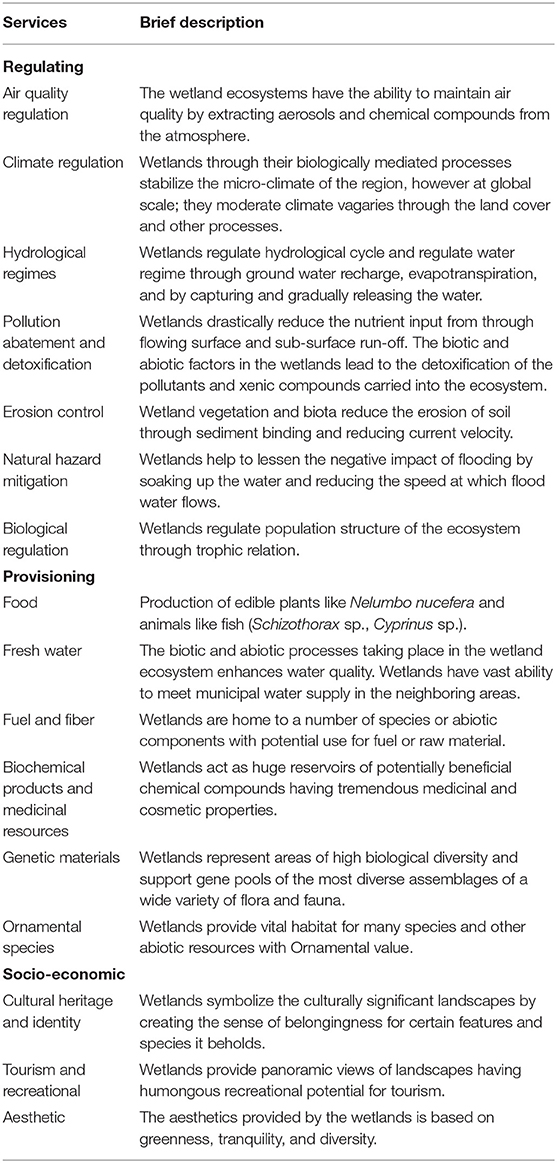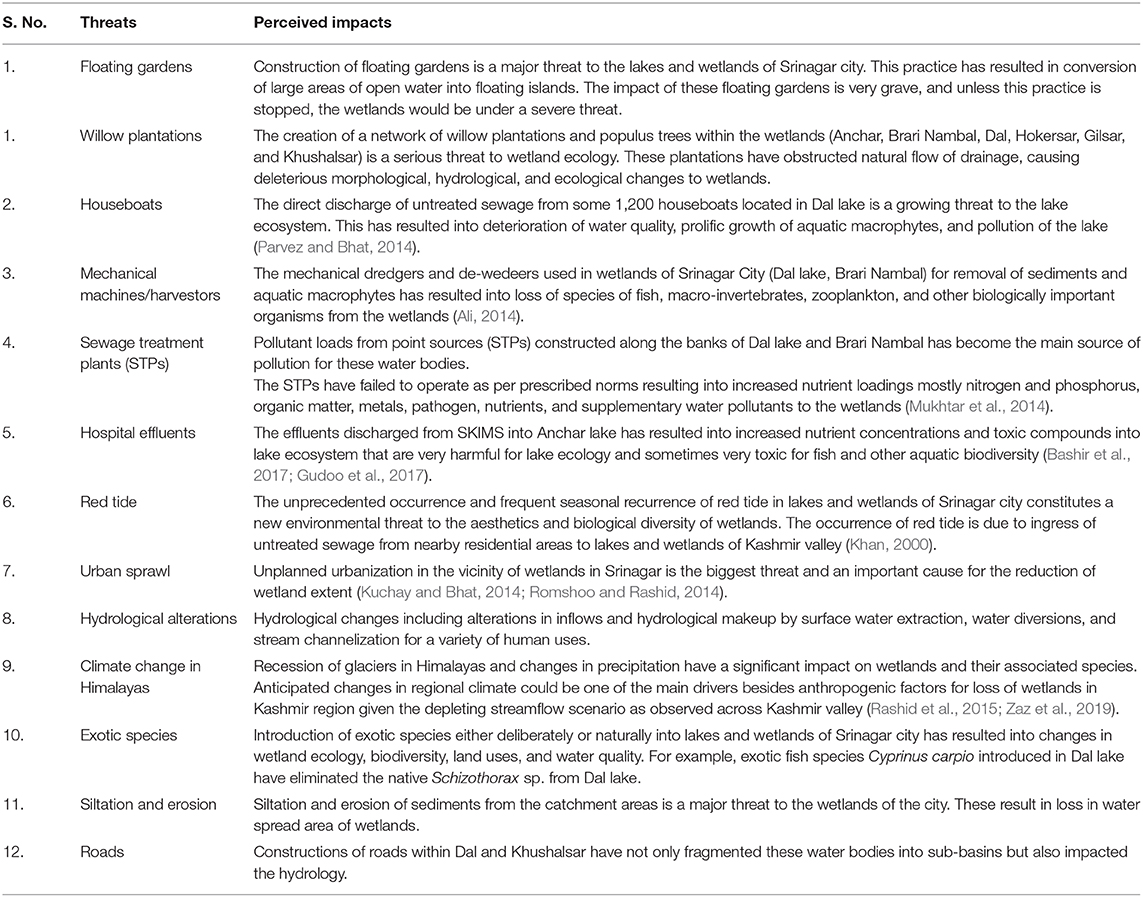- 1Department of Environmental Science, School of Earth and Environmental Sciences, University of Kashmir, Hazratbal Srinagar, India
- 2Geoinformatics Program, School of Earth and Environmental Sciences, University of Kashmir, Hazratbal Srinagar, India
- 3Department of Environmental Science, Uttarakhand Technical University, Dehradun, India
Wetlands are the most diverse, highly dynamic, productive, and ecologically sensitive areas in Earth. In Kashmir Himalaya, Srinagar city is bestowed with a large number of picturesque wetlands. These wetlands are important in regulating ecosystem services such as providing fresh water supplies, food products, fisheries, water purification, harbor biodiversity, and regulation of regional climate. These are also important as socio-economic support systems for the city inhabitants and valued as habitats of migratory birds that visit Kashmir valley from different continents of the world. Owing to the increased rate of anthropogenic activities and anthropogenically driven changes in natural processes, these wetlands are degrading at an alarming rate, seriously affecting their health and water quality. The major threats to wetlands include pollution, land use and land cover changes, urbanization and encroachments, and climate change. The intensive agricultural practices, introduction of exotic species, and changes in hydrological flows during the past few decades have resulted in degradation of wetlands over this region. Sustainable management of wetlands is crucial as these ecosystems offer an array of ecological functions that sustain livelihoods all over the world. This review provides special insights about the significant changes in spatial scale, land use and land cover changes, and water quality of major wetlands in Srinagar city.
Introduction
Wetlands are ecosystems intermediate between aquatic and terrestrial systems, which are permanently or seasonally covered with shallow water (Mitsch and Gosselink, 1986). They occupy ~6% of earth's land surface (Maltby, 1988). Wetlands are productive (Ghermandi et al., 2008) and biologically diverse ecosystems (Keddy et al., 2009). They provide numerous socio-economic and ecosystem services (Prasad et al., 2002; Ramsar Convention Bureau., 2002) including wildlife habitat, maintenance and conservation of biodiversity (Mitsch and Gosselink, 2007; Whitehouse et al., 2008), water purification (Brown et al., 2000), fisheries and recreation (Keddy, 2010; Junk et al., 2013), flood control (Penatti et al., 2015), water supply (Lemly, 1994), nutrient removal (Raich and Schlesinger, 1992), carbon sequestration (Turner et al., 2000), and environmental restoration (Fink and Mitsch, 2007; Moreno et al., 2007). Wetlands serve as a means of livelihood for rural populations (Turyahabwe et al., 2013; Lamsal et al., 2015), particularly in developing nations and are greatly valued by many cultures (Ghermandi et al., 2010; Maltby and Acreman, 2011). Owing to the high potential of wetlands for agricultural productivity, fisheries, and water supply, many of the wetlands of the world have been historically relied upon by human civilizations. In spite of the ecosystem functions and sustenance of human livelihoods, 30–90% of the wetlands of the world are strongly modified or lost (Junk et al., 2013; Reis et al., 2017) and many remain threatened and degraded due to high population pressure and urbanization (Central Pollution Control Board, 2008; Bassi et al., 2014). Davidson (2014) reviewed 189 reports and estimated wetland loses as 64–71% in the twenty-first century. There was a decline of 69–75% in the extent of inland wetlands and 62–63% decline in the extent of coastal wetlands. Wetland losses continue in the twenty-first century. Leadley et al. (2014) found the Wetland Extent Index and estimated ~40% decline in coverage of both inland and coastal/marine wetland ecosystems during last 40 years due to fragmentation and degradation (Figure 1).
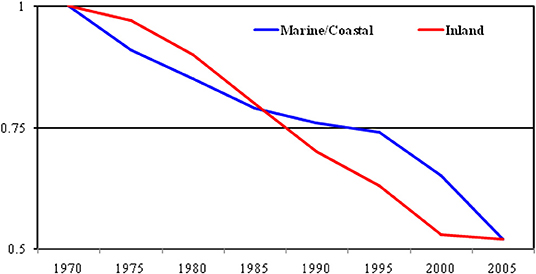
Figure 1. Global Wetland Extent Index (Source: Leadley et al., 2014).
Presently, the wetland ecosystems are under tremendous stress due to massive land system changes and infrastructure development (Pramod et al., 2011), as well as intensification of agricultural and industrial activities (Bassi et al., 2014), manifested by the decline in their areal extent resulting in a decline in the hydrological, economic, and ecological functions (Bassi et al., 2014). This has led to adoption of various policies and approaches for conservation, protection, and management of wetlands [Ministry of Environment and Forests (MoEF), 2006].
Current Status of Wetlands in Srinagar City
Srinagar city in Kashmir Himalaya has a rich natural heritage of magnificent lakes and picturesque wetlands (Figure 2) lying along the floodplains of river Jhelum, which are famous waterfowl habitats (Kaul and Pandit, 1980; Habib, 2014). Besides being a source of attraction for tourists from all over the world, these freshwater ecosystems of the Kashmir Himalaya have been playing a great role in the socio-cultural activity and economy (Kaul and Pandit, 1980; Pandit, 1982) of the valley since ancient times. They are a great source of natural products like fish, fodder, vegetables, tourism, and a variety of economically important aquatic plants (Pandit and Qadri, 1990; Bano et al., 2018). However, over the last few decades, the deteriorating water quality (Verma et al., 2001; Rashid et al., 2017a) and land system changes (Romshoo and Rashid, 2014; Rashid and Aneaus, 2019) including encroachment of otherwise notified wetland areas and depleting stream flows (Mitsch and Gosselink, 2000; Showqi et al., 2014; Romshoo et al., 2015) have impacted their health (Iwanoff, 1998; Chauhan, 2010; Naja et al., 2010; Reza and Singh, 2010).
Nowadays, wetlands are being recognized as “wastelands” serving as grounds for a variety of waste materials (Khan et al., 2004; Bano et al., 2018). The increasing trend of conversion of agricultural lands into urban areas is currently one of the dominant patterns of land use change in the valley of Kashmir (Rashid and Romshoo, 2013; Rashid et al., 2017b). This pattern of land use change has the potential to alter the composition and functional processes of wetlands by changing the hydrological regimes and sedimentation processes besides the flux of nutrient materials. The ecological consequences of agricultural runoff and municipal wastewater discharges have resulted into widespread eutrophication (Khan and Ansar, 2005; Badar et al., 2013a). The conversion of forested and agricultural areas into built up areas has impaired the water quality (Rather et al., 2016) that has led to the extirpation of local populations of aquatic species. As a result, many freshwater wetlands have altogether vanished or are facing severe anthropogenic pressures. The harmful social, financial, and ecological impacts of declining biodiversity and degrading water quality are a matter of concern (Verma et al., 2001; Bassi et al., 2014). Most of these wetlands used to act as buffers soaking flood waters but the encroachment and infrastructure development within these wetlands has reduced their water holding capacity, increasing the vulnerability of people toward flooding (Romshoo et al., 2017). The central business hub of Srinagar, the capital city, is often affected during a normal precipitation event as the drainage channels that used to drain out storm water runoff have mostly been taken over by concrete surfaces (Rashid and Naseem, 2008). The changes in the spatial extent of lakes and wetlands in Srinagar are presented in Table 1. As a result of unplanned urbanization, encroachments, and population pressures, nearly 91.2 km2 of wetland area has been lost between 1911 and 2004 (Rashid and Naseem, 2008).
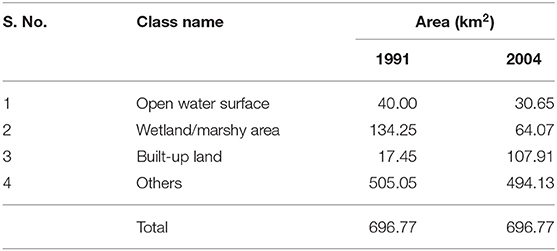
Table 1. Changes in the spatial extent of lakes and wetlands of Srinagar between 1911 and 2004 (Source: Rashid and Naseem, 2008).
Anchar Lake
Anchar is a semiurban, single basin lake situated between 34°07′-34°10′ N latitudes and 74°46′-74°48′ E longitudes at an altitude of 1,583 m above mean sea level (a.m.s.l.). The lake is situated about 14 km from Srinagar city on the northwestern part. The lake covered an area of 19.54 km2 during 1893–1894 (Lawrence, 1895). Since then, the area of the lake declined substantially to 6.5 km2 (Jeelani and Kaur, 2012). The current area of the lake is 4.26 km2 (Sushil et al., 2014; Fazili et al., 2017). The water supply of Anchar Lake is maintained by Sindh, a tributary stream of Jhelum and Achan Nallah in addition to springs along the vicinity of lake. The lake has a vast catchment area that comprised a mixture of residential, forest, agricultural, and horticultural land (Jeelani and Kaur, 2012; Bhat et al., 2013). The last few decades have resulted in the decline of the water quality of the lake (Farooq et al., 2018; Table 2). The main causes of degradation of Anchar Lake are anthropogenic activities, encroachments, sewage, and dumping of domestic wastes including polythene, clothes, plastic bottles, and effluents from hospitals and wastewater treatment plants (Najar and Khan, 2012; Bhat et al., 2013; Fazili et al., 2017).
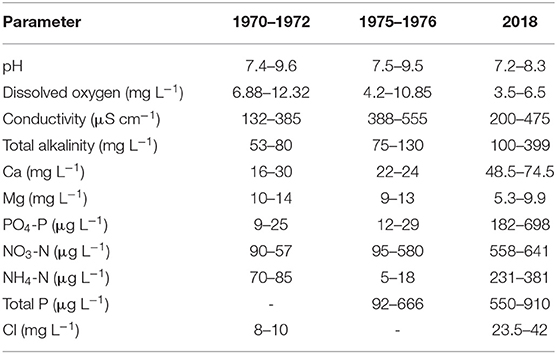
Table 2. Long-term water quality changes in Anchar Lake (Source: Kaul, 1977; Kaul et al., 1978; Farooq et al., 2018).
Dal Lake
Dal is an urban lake, situated between 34°5′-34°6′ N latitude and 74°8′-74°9′ E longitude at an altitude of 1,584 m a.m.s.l. The lake has been formed due to fluviatile activity of river Jhelum (Rather, 2012) and is fed by Dagwan stream (Sabha et al., 2019). The lake is under high stress due to anthropogenic influences (Badar et al., 2013b; Khanday et al., 2018). During 1200 A.D., the extent of Dal Lake was about 75 km2 (Wani et al., 2013). The lake covered an area of ~32 km2 in 1859 and has shrunk to 24 km2 (including the lake interiors) mainly due to the expansion of settlement areas and proliferation of settlements (Rashid et al., 2017a). The lake was abundantly supporting sensitive aquatic macrophytes including Eurayle ferox (Lawrence, 1895; Mukerjee, 1921) and Chara sp. (Mukerjee, 1921), but as the pollution and eutrophication of the lake continued, the species were pressed to extinction from the lake (Kak, 2010). While it is believed that boatmen (locally known as Ha'enz) are the main culprits responsible for changing land use and land cover of the lake (Fazal and Amin, 2012), there are policy failures that have led to the majority of the lake area being highly deteriorated. The land use patterns and land cover of the lake are presently composed of open water (10.5 km2), aquatic vegetation (8.64 km2), floating gardens (2.89 km2), and settlements (2.02 km2) (Rashid et al., 2017a). The historical changes in the land system of the Dal Lake are shown in Table 3.

Table 3. Land system changes within Dal lake from 1859 to 2013 (Source: Rashid et al., 2017a).
During the last 50 years, the rapid increase in houseboats, population pressure, encroachment, urbanization, pollution, and sewage has resulted in the decline of the quality of lake water (Amin et al., 2014). About 1,200 houseboats (Fazal and Amin, 2012) present in the lake are a major source of untreated sewage and pollution to the lake (Tanveer et al., 2017). The historical water quality changes in Dal Lake are reflected in Table 4.
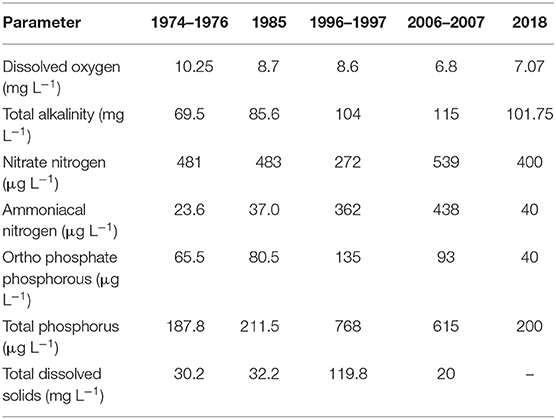
Table 4. Water quality changes in Dal ecosystem (Source: Trisal, 1977; Abubakr and Kundangar, 2009; Khanday et al., 2018).
Brari Nambal
Brari Nambal is a marshy lagoon situated between 34°05′12.88″N and 74° 48′50″E in Srinagar city. It is connected to the Dal Lake via a channel on the eastern side. Previously, there was an outlet channel known as Nallah Mar/Mar canal that used to provide navigability to Dal Lake to Anchar Lake via Khushalsar (Tantray and Singh, 2017). In addition, the Mar canal used to take the excess water from Brari Nambal to Khushalsar Lake. However, the channel was filled and converted into a motorable road during the 1970s (Wani et al., 2014), which resulted into the alteration of the hydrology (Figure 3). Brari Nambal has a narrow outlet on the western side and drains into river Jhelum through an underground channel. In 1971, Brari Nambal covered an area of 1 km2 (water body−0.28 km2 and Marshy area−0.72 km2) which reduced to 0.77 km2 by 2002 (water body−0.21 km2 and marsh−0.56 km2) (Fazal and Amin, 2011).
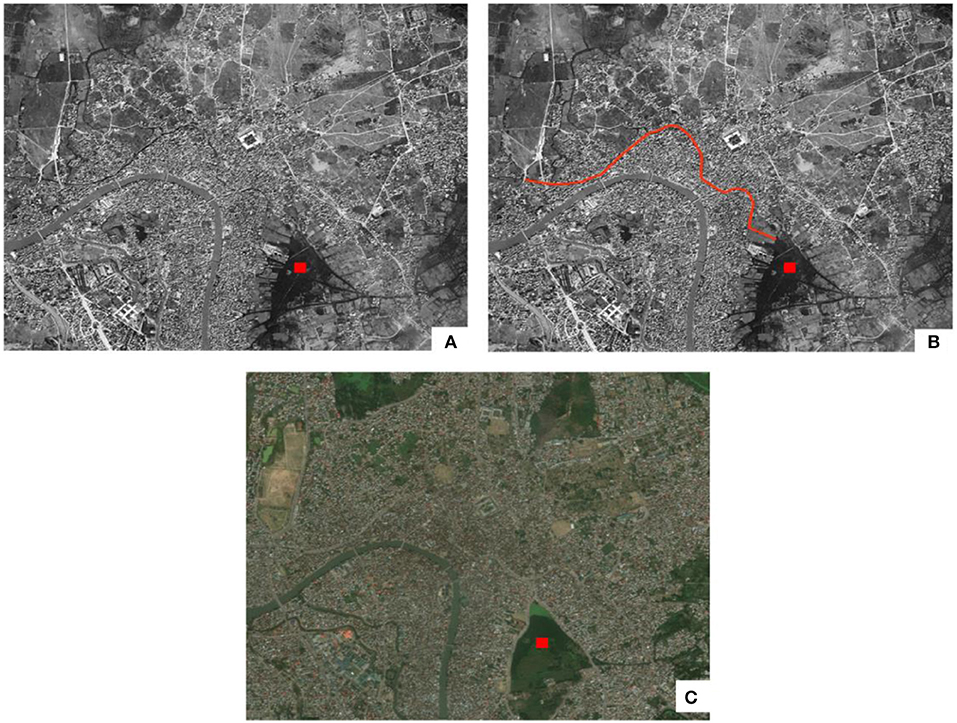
Figure 3. Filling up of Mar Canal as seen from earth observation data (A,B) Declassified CORONA spy images showing Mar canal in 1965. Red Line in (B) indicates Mar canal. (C) Road built by filling up the Mar Canal. Red dot indicates Brari Nambal.
The population pressure, pollution, encroachments, and urbanization have led to great stress on the wetland, thereby deteriorating the water quality to the verge of extinction. Most of the sewage generated in the vicinity is treated at a sewage treatment plant constructed on the southern area of the wetland. The outflows from the sewage treatment plant have become a major source of pollution and nutrients to the wetland. The sewage treatment plant has failed in its operation as per prescribed norms; as a consequence, it discharges partially treated sewage, thereby turning the wetland into a gutter (Mukhtar et al., 2014).
Gilsar and Khushalsar Lakes
Gilsar and Khushalsar are twin lakes in highly deteriorated condition located toward the northwest of Srinagar city. The lakes receive waters from the Nigeen basin of Dal Lake via a water channel—Nallah Amir Khan (Nissa and Bhat, 2016). The total area of the lake is 1.06 km2, and the average depth of the lake is 3.6 m. The lakes have been encroached upon at many places with illegal construction and landfilling (Chowdhury, 2017). These lakes receive sewage inputs estimated about 465 million liters per day (MLD) from the catchment containing ~2 metric tons (MT) of phosphorus and 1.71 MT of nitrogen (Kundangar, 2002) that has resulted into the proliferated growth of aquatic weeds and subsequent degradation of water quality.
Hokersar Wetland
Hokersar is the queen of the wetlands of Kashmir valley situated between 34° 06′ N latitude and 74° 05′ E longitude having an altitude of 1,580 m a.m.s.l. in the northern part of Doodhganga catchment, 10 km west of Srinagar city. The water supply of Hokersar wetland is maintained by the Doodhganga stream on the eastern side and by the Sukhnag stream on the western side. The depth of the wetland varies from a maximum of 2.5 m to a minimum of 0.7 m during spring and autumn, respectively. Hokersar is a game reserve and habitat for about 2 million species of migratory birds of Europe, Siberia, and Central Asia. The marshland supports various ecological and economic services, which include fisheries, food products, freshwater, and purification of water, and regulates global climate (Davis, 1993; Romshoo and Rashid, 2014). The wetland supports a broad range of hydrological functions, for example, regulation of floods, recharge of groundwater, control stream flow (Joshi et al., 2002), and carbon sequestration (Romshoo and Rashid, 2014). In this context, the wetland was designated as a Ramsar site in November 2005. Due to increased human intervention and changing natural processes (Joshi et al., 2002), the area of the wetland has declined from 18.75 km2 in 1969 to 13.00 km2 in 2008 (Romshoo and Rashid, 2014; Table 5). This wetland has lost 5.75 km2 of area during the last four decades (Romshoo and Rashid, 2014). During the last two to three decades, macrophytic species like Acorus calamus, Euryale ferox, and Nelumbo nucifera within the wetland had disappeared (Khan et al., 2004). The wetland is now choked by invasive species like Azolla spp., Salvinia natans, and Menynanthese spp. (Khan et al., 2004; Bano et al., 2018). The increased sillt load from the catchment area due to deforestation of higher reaches is the possible cause for the disappearance of the species and depletion of water depth, which has been reported to have reduced from 1.12 m (Pandit, 1980) to 0.63 m (Rather and Pandit, 2002). It is also pertinent to mention that during the last few decades, the water quality of the wetland has deteriorated (Shah et al., 2019) severely (Table 6), mainly attributed to urbanization in the vicinity (Romshoo et al., 2011).
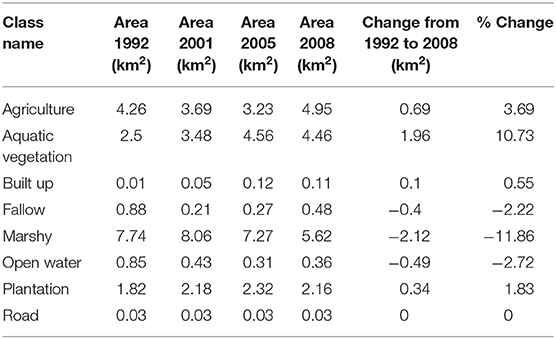
Table 5. Area covered by different land use land cover types from 1992 to 2008 within Hokersar wetland (Source: Romshoo and Rashid, 2014).
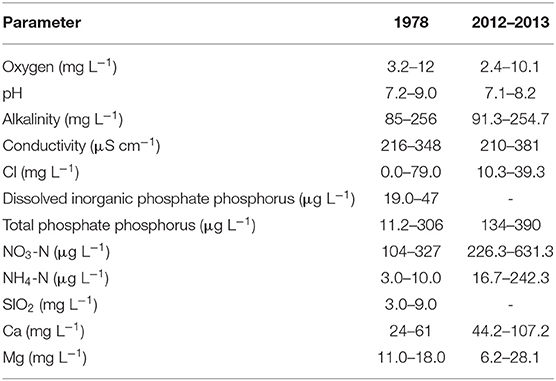
Table 6. Range value of various chemical parameters of Hokersar wetland (Source: Kaul et al., 1978; Kaul and Trisal, 1985; Shah et al., 2019).
Brief Inventory on Services Provided by Wetlands
Having only a coverage of 0.6% of the Earth's surface, wetlands supply a tremendous proportion of ecosystem services such as recreational amenities, flood control, storm buffering, biodiversity, climate regulation, and socio-cultural values. They are important habitats for biodiversity contributing to primary productivity and home to many important migratory birds. Thus, wetlands have a diverse fauna with a relatively large number of endemic species. Goods and services derived from wetlands include livestock and cultivation, fisheries, fiber for construction and handicraft production, fuel wood, hunting for water fowl and other wildlife, aesthetic value of wetlands, storm buffering, flood water storage and stream flow regulation, water flow, sediment and nutrient cycling—water quality improvements, erosion control, carbon sequestration—climate change and mitigation, and cultural knowledge and traditions (Eftec, 2005). Wetlands are believed to have distinctive ecological features, which provide various goods and services to mankind. They constitute a natural resource of great economic, scientific, cultural, and recreational value. Wetland characteristics such as biodiversity, abiotic components, and ecological processes regulate a large number of functions that are first transformed into a list of services that can then be measured in appropriate units (biophysical or otherwise) and later used for economic valuation. Ecosystem functions represent the potential for benefits that may or may not be used directly by humans. Usually, the same function is linked to two or more ecosystem services. Some of the vital functions of the wetlands are listed in Table 7.
Threats to Wetlands
Among the freshwater ecosystems, wetlands are the most widely used and are heavily exploited for sustainability and livelihood (Molur et al., 2011). The main threats to wetlands in Srinagar city are attributed to anthropogenic pressures that include urbanization (Farooq and Muslim, 2014), land use changes (Fazal and Amin, 2011), and large-scale encroachments (Wani and Khairkar, 2011; Kuchay and Bhat, 2014) in the catchment as well as in the wetlands itself (Rather et al., 2016). Besides, natural siltation associated with the anthropogenic siltation brought about by deforestation in the catchment areas has also been an important factor resulting in the loss of wetlands (Pandit and Qadri, 1990; Pandit, 1991; Shah et al., 2017; Amin and Romshoo, 2019). Another important driver of the loss of wetlands comes in the form of problems relating to drainage (Romshoo et al., 2017; Alam et al., 2018). The huge inflow of sewage from the catchment areas into the water bodies has resulted in excessive macrophytic growth (Dar et al., 2014). The main causes of wetland degradation in Srinagar are summarized in Table 8.
Management of Wetlands
In Srinagar, wetland ecosystems are continuously seen as isolated systems and hardly figure in any management plans. The principal responsibility for management of wetland ecosystems in Srinagar is with the Lakes and Waterways Development Authority (LAWDA), Srinagar. Although one of the wetlands in Srinagar—Hokersar—was declared as a Conservation Reserve by the Jammu and Kashmir Wildlife Protection Act (1978)1 and selected as a Ramsar site under the Ramsar Convention on wetlands of international importance on 8 November, 2005, the wetland ecosystems are overlooked in management plans. A wetland management plan would be imperative for deriving sustained ecological and socio-economic services from these important freshwater ecosystems. The wetland management plan would adhere to various actions for protection, restoration, and manipulation of wetland ecosystems that provide values and functioning advocating to their sustainable usage (Walters, 1986).
The various strategies involved in management process should aim at:
• Reducing the impact of current anthropogenic pressures and natural processes for long-term protection of wetlands.
• Prohibiting any kind of anthropogenic interference in wetland areas particularly where much of the natural functioning of wetland ecosystems have already been lost.
• Regulating inflows using water quality standards set by organizations for wetlands for their regular functioning while deriving monetary benefits in a sustainable way.
• Creating barrier or green zones for protection of wetland ecosystems, restraining detrimental human actions in the demarcated area of wetland ecosystems for restoring the wetlands.
• Addressing and treating point sources and non-point sources of pollution in the vicinity and catchments that would improve the trophic status of wetlands in peril.
• Setting up of robust treatment plants (STPs) within the wetlands and their immediate catchments that would improve wetland health.
• Involvement of local people, colleges, and universities for regular monitoring of the health of wetlands and establish a civil society–academia–policy interface that will help in the better understanding of these ecologically sensitive areas for formulating effective conservation and restoration efforts.
• Workshops and other programs with active participation of school and university children in the vicinity of wetland ecosystems on a regular basis so that hands-on education is imparted to the dwellers and inhabitants for protection of wetlands.
Conclusions
Wetlands are biologically most diverse and economically valuable ecosystems all over the world. They cover about 6% of the surface of the earth and provide important ecological and economic services. Srinagar city in the valley of Kashmir has several lakes and wetlands. These are important as socio-economic assets and function as absorption basins for flood waters. They help in the maintenance of biodiversity, purification, and recharge of groundwater. The wetlands of Srinagar city are degrading at an alarming rate mainly due to anthropogenic pressures and climate change. The major threats to wetlands in the city include pollution, siltation, encroachments, urbanization, and establishment of floating gardens. Robust management strategies must be adopted for conservation and protection of wetland ecosystems to ensure sustainable socio-economic and ecological benefits.
Future Perspectives
Wetlands all over the world function as important ecological assets and contribute largely to the well-being of the people. Studies have shown that the monetary value of wetland services far exceeds those provided by terrestrial ecosystems. Nowadays, there is a growing trend of utilizing constructed wetlands for treatment of wastewaters and industrial effluents. Due to encroachments and land use changes, the area of lakes and wetlands has drastically reduced during the last few decades. Therefore, the future of lakes and wetlands seems to be at stake, which would not only impact socio-economy but also increase the vulnerability of people to disasters. Despite the regulations and the presence of wetland management authorities, wetlands continue to degrade in the Kashmir region. Keeping in view their ecosystem services, wetlands need to be conserved for future generations. The wetland management authorities of Srinagar city need to look into the ecological degradation and the land conversion going on within and around the wetlands. The areas that require aggressive management approaches are restricting the expansion of floating gardens and limiting the growth of aquatic vegetation. It is these hotspots that are earth-filled and used for construction of houses. The siltation of wetlands in Srinagar is another important concern that should be looked into by the policy-makers so as to restore their original water holding capacities. This is important for reducing the vulnerability of population in Srinagar to floods. The effects of mismanagement of city wetlands will become visible only in a few decades and the wetland encroachers will bear consequences similar to what Srinagarites experienced during 2014 mega flood.
Author Contributions
ShD, SB, and IR conceived, designed, and drafted this review, while SaD author helped in screening the relevant literature besides giving inputs on draft. All authors together at the end gave final shape to this manuscript.
Conflict of Interest
The authors declare that the research was conducted in the absence of any commercial or financial relationships that could be construed as a potential conflict of interest.
Acknowledgments
The authors express gratitude to Ms. Sheikh Aneaus, Junior Research Fellow, Department of Earth Sciences (Geoinformatics Program) for preparing the map showing the wetlands of Srinagar city. The authors would also like to acknowledge the comments of three reviewers whose inputs helped in improving the structure and quality of the manuscript. Thanks are also due to the Associate Editor, Dr. Micheal M. Douglas, for timely processing of the manuscript.
Footnote
References
Abubakr, A., and Kundangar, M. R. D. (2009). Three decades of Dal Lake pollution – restoration. J. Ecol. Environ. Conserv. 15, 825–833.
Alam, A., Bhat, M. S., Farooq, H., Ahmad, B., Ahmad, S., and Sheikh, A. H. (2018). Flood risk assessment of Srinagar city in Jammu and Kashmir, India. Int. J. Disaster Resilience Built Environ. 9, 114–129. doi: 10.1108/IJDRBE-02-2017-0012
Ali, U. (2014). Stress of environmental pollution on zooplanktons and their comparative studies in Dal Lake, Wular lake Anchar lake and Manasbal Lake, in Srinagar, Kashmir. Int. J. Eng. Sci. 3, 39–44.
Amin, A., Fazal, S., Mujtaba, A., and Singh, S. K. (2014). Effects of land transformation on water quality of Dal lake, Srinagar, India. J. Indian Soc. Remote Sens. 42, 119–128. doi: 10.1007/s12524-013-0297-9
Amin, M., and Romshoo, S. A. (2019). Comparative assessment of soil erosion modelling approaches in a Himalayan watershed. Model. Earth Syst. Environ. 5, 175–192. doi: 10.1007/s40808-018-0526-x
Badar, B., Romshoo, S. A., and Khan, M. A. (2013a). Modelling catchment hydrological responses in a Himalayan Lake as a function of changing land use and land cover. J. Earth Syst. Sci. 122, 433–449. doi: 10.1007/s12040-013-0285-z
Badar, B., Romshoo, S. A., and Khan, M. A. (2013b). Integrating biophysical and socioeconomic information for prioritizing watersheds in a Kashmir Himalayan lake: a remote sensing and GIS approach. Environ. Monit. Assess. 185, 6419–6445. doi: 10.1007/s10661-012-3035-9
Bano, H., Lone, F. A., Bhat, J. I. A., Rather, R. A., Malik, S., and Bhat, M. A. (2018). Hokersar Wet Land of Kashmir: its utility and factors responsible for its degradation. Plant Arch. 18, 1905–1910.
Bashir, M., Chauhan, R., Mir, M. F., Ashraf, M., Amin, N. A. M., Bashir, S. A., et al. (2017). Effect of pollution on the fish diversity in Anchar Lake, Kashmir. Int. J. Fisheries Aquatic Stud. 5, 105–107.
Bassi, N., Kumar, M. D., Sharma, A., and Pardha-Saradhi, P. (2014). Status of wetlands in India: a review of extent, ecosystem benefits, threats and management strategies. J. Hydrol. Reg. Stud. 2, 1–19. doi: 10.1016/j.ejrh.2014.07.001
Bhat, S. A., Meraj, G., Yaseen, S., Bhat, A. R., and Pandit, A. K. (2013). Assessing the impact of anthropogenic activities on spatio-temporal variation of water quality in Anchar lake, Kashmir Himalayas. Int. J. Environ. Sci. 3, 1625–1640. doi: 10.6088/ijes.2013030500032
Brown, D. S., Kreissl, J. F., Gearhart, R. A., Kruzic, A. P., Boyle, W. C., Otis, R. J., et al. (2000). Constructed Wetlands Treatment of Municipal Wastewaters. EPA/625/R-99/010 (NTIS PB2001-101833). Available online at: https://nepis.epa.gov/Exe/ZyPDF.cgi/30004TBD.PDF?Dockey=30004TBD.PDF (accessed May 5, 2019).
Central Pollution Control Board, CPCB. (2008). Status of Water Quality in India 2007. New Delhi: Central Pollution Control Board, Ministry of Environment and Forests, Government of India.
Chauhan, S. S. (2010). Mining, development and environment: a case study of bijolia mining area in Rajasthan, India. J. Hum. Ecol. 31, 65–72. doi: 10.1080/09709274.2010.11906299
Chowdhury, C. L. (2017). “Greater Srinagar and Dal Lake integrated environmental project proposal–a review,” in Geomechanics and Water Engineering in Environmental Management, ed R. N. Chowdhury (London, UK: Routledge), 233–266. doi: 10.1201/9780203753552-7
Dar, N. A., Pandit, A. K., and Ganai, B. A. (2014). Factors affecting the distribution patterns of aquatic macrophytes. Limnol. Rev. 14, 75–81. doi: 10.2478/limre-2014-0008
Davidson, N. C. (2014). How much wetland has the world lost? Long-term and recent trends in global wetland area. Mar. Freshwater Res. 65, 934–941. doi: 10.1071/MF14173
Eftec (2005). The Economic, Social and Ecological Value of Ecosystem Services: A Literature Review. Final report for the Department for Environment, Food and Rural Affairs. Eftec, 42.
Farooq, M., and Muslim, M. (2014). Dynamics and forecasting of population growth and urban expansion in Srinagar City-A Geospatial Approach. Int. Arch. Photogramm. Rem. Sens. Spatial Inf. Sci. 40, 709–716. doi: 10.5194/isprsarchives-XL-8-709-2014
Farooq, R., Chauhan, R., and Mir, M. F. (2018). Deterioration of water quality of Anchar Lake as indicated by analysis of various water quality parameters. Int. J. Adv. Res. Sci. Eng. 7, 2551–2558.
Fazal, S., and Amin, A. (2011). Impact of urban land transformation on water bodies in Srinagar City, India. J. Environ. Protec. 2, 142–153. doi: 10.4236/jep.2011.22016
Fazal, S., and Amin, A. (2012). Hanjis activities and its impact on Dal Lake and its environs (a case study of Srinagar City, India). Res. J. Environ. Earth Sci. 4, 511–524.
Fazili, M. F., Bhat, B. A., and Ahangar, F. A. (2017). Avian diversity of Anchar Lake, Kashmir, India. N. Y. Sci. J. 10, 92–97.
Fink, D. F., and Mitsch, W. J. (2007). Hydrology and nutrient biogeochemistry in a created river diversion oxbow wetland. Ecol. Eng. 30, 93–102. doi: 10.1016/j.ecoleng.2006.08.008
Ghermandi, A., van den Bergh, J. C. J. M., Brander, L. M., de Groot, H. L. F., and Nunes, P. A. L. D. (2010). Values of natural and human-made wetlands: a meta-analysis. Water Resour. Res. 46, 1–12. doi: 10.1029/2010WR009071
Ghermandi, A., van den Bergh, J. C. J. M., Brander, L. M., and Nunes, P. A. L. D. (2008). “The economic value of wetland conservation and creation: a meta-analysis, in Working Paper 79 (Milan: Fondazione Eni Enrico Mattei). doi: 10.2139/ssrn.1273002
Gudoo, M. Y., Gupta, A., and Mir, M. F. (2017). Diversity, distribution and abundance of macroinvertebrates in Anchar Lake, Srinagar, Kashmir, J & K, India. Int. J. Curr. Res. 9, 52390–52396.
Habib, M. (2014). Bird community structure and factors affecting the avifauna of Hokersar wetland Kashmir. Int. J. Curr. Res. 6, 7397–7403.
Iwanoff, A. (1998). Environmental impacts of deep opencast limestone mines in Aegerdorf, Northern Germany. Mine Water Environ. 17, 52–61. doi: 10.1007/BF02687244
Jeelani, M., and Kaur, H. (2012). Ecological understanding of Anchar Lake, Kashmir. Int. J. Environ. Rehabil. Conserv. 3, 21–32.
Joshi, P. K., Humayun, R., and Roy, P. S. (2002). Landscape dynamics in Hokersar wetland-an application of geospatial approach. J. Indian Soc. Remote Sens. 30, 1–5. doi: 10.1007/BF02989971
Junk, W. J., An, S., Finlayson, C. M., Gopal, B., Květ, J., Mitchell, S. A., et al. (2013). Current state of knowledge regarding the world's wetlands and their future under global climate change: a synthesis. Aquat. Sci. 75, 151–167. doi: 10.1007/s00027-012-0278-z
Kak, A. M. (2010). Euryale ferox Salisb. (Juwak) in Kashmir lakes (J&K State), India. J. Econ. Taxonomic Bot. 34, 1–11.
Kaul, V. (1977). Limnological Survey of Kashmir lakes with reference to trophic status and conservation. Int. J. Ecol. Environ. Sci. 3, 29–44.
Kaul, V., and Pandit, A. K. (1980). “Management of wetland ecosystems as wildlife habitats in Kashmir,” in Proceedings of the International Seminar: Management of Environment, ed B. Patel (Bombay: Bhabha Atomic Research Centre, 31–53.
Kaul, V., and Trisal, C. L. (1985). “Ecology and conservation of the freshwaterlakes of Kashmir,” in National Symposium Evolution Environment, eds S. D. Misra, D. N. Sen, and I. Ahmad (Jodhpur: Sp. Vol. Geobios, 164–170.
Kaul, V., Trisal, C. L., and Handoo, J. K. (1978). “Distribution and production of macrophytes in some water bodies of Kashmir,” in Glimpses of Ecology, eds J. S. Singh, and B. Gopal (Jaipur: International Scientific Publications, 313–334.
Keddy, P. A. (2010). Wetland Ecology: Principles and Conservation. New York, NY: Cambridge University Press.
Keddy, P. A., Fraser, L. H., Solomeshch, A. I., Junk, W. J., Campbell, D. R., Arroyo, M. T. K., et al. (2009). Wet and wonderful: the world's largest wetlands are conservation priorities. Bioscience 59, 39–51. doi: 10.1525/bio.2009.59.1.8
Khan, F. A., and Ansar, A. A. (2005). Eutrophication: an ecological vision. Botanical Rev. 71, 449–482. doi: 10.1663/0006-8101(2005)071[0449:EAEV]2.0.CO;2
Khan, M. A. (2000). Anthropogenic eutrophication and red tide outbreak in lacustrine systems of the Kashmir Himalaya. Acta Hydrochem. Hydrobiol. 28, 95–101. doi: 10.1002/(SICI)1521-401X(20002)28:2<95::AID-AHEH95>3.0.CO;2-2
Khan, M. A., Shah, M. A., Mir, S. S., and Bashir, S. (2004). The environmental status of a Kashmir Himalayan wetland game reserve: aquatic plant communities and eco-restoration measures. Lakes Reserv. Res. Manage. 9, 125–132. doi: 10.1111/j.1440-1770.2004.00242.x
Khanday, S. A., Romshoo, S. A., Jehangir, A., Sahay, A., and Chauhan, P. (2018). Environmetric and GIS techniques for hydrochemical characterization of the Dal Lake, Kashmir Himalaya, India. Stochastic Environ. Res. Risk Assess. 32:3151. doi: 10.1007/s00477-018-1581-6
Kuchay, N. A., and Bhat, M. S. (2014). Analysis and simulation of urban expansion of Srinagar City. Trans. Inst. Indian Geograp. 36, 109–121.
Kundangar, M. R. D. (2002). Pollution status of wetlands of Khushalsar and Gilsar, Srinagar, Kashmir. A report submitted to UEE Department, Government of J&K.
Lamsal, P., Pant, K. P., Kumar, L., and Atreya, K. (2015). Sustainable livelihoods through conservation of wetland resources: a case of economic benefits from Ghodaghodi Lake, Western Nepal. Ecol. Soc. 20:10. doi: 10.5751/ES-07172-200110
Leadley, P. W., Krug, C. B., Alkemade, R., Pereira, H. M., Sumaila, U. R., Walpole, M., et al. (2014). Progress Towards the Aichi Biodiversity Targets: An Assessment of Biodiversity Trends, Policy Scenarios, and Key Actions. Montreal, QC: Secretariat of the Convention on Biological Diversity.
Lemly, A. D. (1994). Irrigated agriculture and freshwater wetlands: a struggle for coexistence in the western United States. Wetlands Ecol. Manage. 3, 3–15. doi: 10.1007/BF00177292
Maltby, E. (1988). “Global wetlands - history, current status and future,” in The Ecology and Management of Wetlands, eds D. D. Hook, W. H. McKee Jr., H. K. Smith, J. Gregory, V. G. Burrell Jr., M. Richard DeVoe, R. E. Sojka, S. Gilbert, R. Banks, L. H. Stolzy, C. Brooks, T. D. Matthews, and T. H. Shear (New York, NY: Springer), 3–14. doi: 10.1007/978-1-4684-8378-9_1
Maltby, E., and Acreman, M. C. (2011). Ecosystem services of wetlands: pathfinder for a new paradigm. Hydrol. Sci. J. 56, 1341–1359. doi: 10.1080/02626667.2011.631014
Ministry of Environment Forests (MoEF) (2006). National Environmental Policy. New Delhi: MoEF, Government of India. Available online at: http://www.indiaenvironmentportal.org.in/files/nep2006e.pdf (accessed May 5, 2019).
Mitsch, W. J., and Gosselink, J. G. (2000). The value of wetlands: importance of scale and landscape setting. Ecol. Econ. 35, 25–33. doi: 10.1016/S0921-8009(00)00165-8
Molur, S., Smith, K. G., Daniel, B. A., and Darwall, W. R. T. (2011). The Status and Distribution of Freshwater Biodiversity in the Western Ghats, India. Cambridge; Gland: International Union for Conservation of Nature. Available online at: https://portals.iucn.org/library/sites/library/files/documents/RL-540-001.pdf (accessed May 5, 2019).
Moreno, D., Pedrocchi, C., Comin, F. A., Garcia, M., and Cabezas, A. (2007). Creating wetlands for the improvement of water quality and landscape restoration in semi-arid zones degraded by intensive agricultural use. Ecol. Eng. 30, 103–111. doi: 10.1016/j.ecoleng.2006.07.001
Mukerjee, S. K. (1921). “The Dal Lake (Kashmir): a study in biotic succession,” in Proceedings of the 8th Indian Science Congress Abstracts (Kolkata), 185.
Mukhtar, F., Bhat, M. A., Bashir, R., and Chisti, H. (2014). Assessment of surface water quality by evaluating the physico-chemical parameters and by checking the water quality index of Nigeen Basin and Brari Nambal Lagoon of Dal Lake, Kashmir. J. Mater. Environ. Sci. 5, 1178–1187.
Naja, G. M., River, O. R., Davis, S. E., and Lent, T. V. (2010). Hydrochemical impacts of limestone rock mining. Water Air Soil Pollut. 217, 95–104. doi: 10.1007/s11270-010-0570-2
Najar, I. A., and Khan, A. B. (2012). Assessment of water quality and identification of pollution sources of three lakes in Kashmir, India, using multivariate analysis. Environ. Earth Sci. 66, 2367–2378. doi: 10.1007/s12665-011-1458-1
Nissa, M., and Bhat, S. U. (2016). An assessment of phytoplankton in Nigeen Lake of Kashmir Himalaya. Asian J. Biol. Sci. 9, 27–40. doi: 10.3923/ajbs.2016.27.40
Pandit, A. K. (1980). Biotic factor and food chain structure in some typical wetlands of Kashmir (Ph.D. thesis). University of Kashmir, Srinagar, J&K, India.
Pandit, A. K. (1982). Looking out for the wildlife in Jammu and Kashmir Himalaya. Environ. Aware. 5, 53–62.
Pandit, A. K. (1991). Conservation of wildlife resources in wetland ecosystems of Kashmir, India. J. Environ. Manage. 33, 143–154. doi: 10.1016/S0301-4797(05)80090-8
Pandit, A. K., and Qadri, S. S. (1990). Floods threatening Kashmir wetlands. J. Environ. Manage. 31, 299–311. doi: 10.1016/S0301-4797(05)80059-3
Parvez, S., and Bhat, S. U. (2014). Searching for water quality improvement in Dal lake, Srinagar, Kashmir. J. Himalayan Ecol. Sust. Dev. 9, 51–64.
Penatti, N. C., de Almeida, T. I. R., Ferreira, L. G., Arantes, A. E., and Coe, M. T. (2015). Satellite-based hydrological dynamics of the world's largest continuous wetland. Remote Sens. Environ. 170, 1–13. doi: 10.1016/j.rse.2015.08.031
Pramod, A., Kumara, V., and Gowda, R. (2011). A Study on physicochemical characteristics of water in Wetlands of hebbe range in Bhadra Wildlife Sanctuary, Mid-Western ghat Region, India. J. Exp. Sci. 2, 9–15.
Prasad, S. N., Ramachandra, T. V., Ahalya, N., Sengupta, T., Kumar, A., Tiwari, A. K., et al. (2002). Conservation of wetlands of India – a review. Trop. Ecol. 43, 173–186.
Raich, J. W., and Schlesinger, W. H. (1992). The global carbon-dioxide flux in soil respiration and its relationship to vegetation and climate. Tellus B 44, 81–99. doi: 10.3402/tellusb.v44i2.15428
Ramsar Convention Bureau. (2002). “Ramsar COP8 DOC. 15: Cultural aspects of wetland,”in 8th Meeting of the Conference of the Contracting Parties to the Convention on Wetlands (Ramsar, Iran, 1971),Valencia, Spain (Gland: The Ramsar Convention Bureau).
Rashid, H., and Naseem, G. (2008). “Quantification of loss in spatial extent of lakes and wetlands in the suburbs of Srinagar city during last century using geospatial approach,” in Proceedings of Taal_2007: The 12th World Lake Conference (Jaipur), 653–658.
Rashid, I., and Aneaus, S. (2019). High resolution earth observation data for assessing the impact of land system changes on wetland health in Kashmir Himalaya, India. Arabian J. Geosci. 12:453. doi: 10.1007/s12517-019-4649-9
Rashid, I., Bhat, M. A., and Romshoo, S. A. (2017b). Assessing changes in the above ground biomass and carbon stocks of Lidder valley, Kashmir Himalaya, India. Geocarto Int. 32, 717–734. doi: 10.1080/10106049.2016.1188164
Rashid, I., and Romshoo, S. A. (2013). Impact of anthropogenic activities on water quality of Lidder River in Kashmir Himalayas. Environ. Monit. Assess. 185, 4705–4719. doi: 10.1007/s10661-012-2898-0
Rashid, I., Romshoo, S. A., Amin, M., Khanday, S. A., and Chauhan, P. (2017a). Linking human-biophysical interactions with the trophic status of Dal Lake, Kashmir Himalaya, India. Limnologica 62, 84–96. doi: 10.1016/j.limno.2016.11.008
Rashid, I., Romshoo, S. A., Chaturvedi, R. K., Ravindranath, N. H., Sukumar, R., Jayaraman, M., et al. (2015). Projected climate change impacts on vegetation distribution over Kashmir Himalayas. Clim. Change 132, 601–613. doi: 10.1007/s10584-015-1456-5
Rather, J. A. (2012). Evaluation of concordance between environment and economy: a resource inventory of Dal Lake. Int. J. Phys. Soc. Sci. 2:10.
Rather, M. I., Rashid, I., Shahi, N., Murtaza, K. O., Hassan, K., Yousuf, A., et al. (2016). Massive land system changes impact water quality of the Jhelum river in Kashmir Himalaya. Environ. Monit. Assess. 188:185. doi: 10.1007/s10661-016-5190-x
Rather, S. A., and Pandit, A. K. (2002). Phytoplankton dynamics in Hokersar wetland, Kashmir. J. Res. Dev. 2, 25–46.
Reis, V., Hermoso, V., Hamilton, S. K., Ward, D., Fluet-Chouinard, E., Lehner, B., et al. (2017). A Global assessment of inland wetland conservation status Bioscience 67, 523–533. doi: 10.1093/biosci/bix045
Reza, R., and Singh, G. (2010). Impact of industrial development on surface water resources in Angul region of Orissa. Int. J. Environ. Sci. 1, 514–522.
Romshoo, S. A., Ali, N., and Rashid, I. (2011). Geoinformatics for characterizing and understanding the spatio-temporal dynamics (1969 to 2008) of Hokersar wetland in Kashmir Himalayas. Int. J. Phys. Sci. 6, 1026–1038.
Romshoo, S. A., Altaf, S., Rashid, I., and Dar, R. A. (2017). Climatic, geomorphic and anthropogenic drivers of the 2014 extreme flooding in the Jhelum basin of Kashmir, India. Geomatics Natl. Hazards Risk 9, 224–248. doi: 10.1080/19475705.2017.1417332
Romshoo, S. A., Dar, R. A., Rashid, I., Marazi, A., Ali, N., and Zaz, S. N. (2015). Implications of shrinking cryosphere under changing climate on the streamflows in the Lidder catchment in the Upper Indus Basin, India. Arct. Antarct. Alp. Res. 47, 627–644. doi: 10.1657/AAAR0014-088
Romshoo, S. A., and Rashid, I. (2014). Assessing the impacts of changing land cover and climate on Hokersar wetland in Indian Himalayas. Arabian J. Geosci. 7, 143–160. doi: 10.1007/s12517-012-0761-9
Sabha, I., Bhat, S. U., Hamid, A., and Rather, J. A. (2019). Monitoring stream water quality of Dagwan stream, an important tributary of Dal Lake, Kashmir Himalaya. Arabian J. Geosci. 12:273. doi: 10.1007/s12517-019-4439-4
Shah, J. A., Pandit, A. K, and Shah, G. M. (2019). Physico-chemical limnology of a shallow lake in the floodplains of western Himalaya from last four decades: present status. Environ. Sys. Res. 8, 1–10. doi: 10.1186/s40068-019-0136-2
Shah, J. A., Pandit, A. K., and Shah, G. M. (2017). Dynamics of physico-chemical limnology of a shallow wetland in Kashmir Himalaya (India). Sustain. Water Resour. Manage. 3, 465–477. doi: 10.1007/s40899-017-0115-6
Showqi, I., Rashid, I., and Romshoo, S. A. (2014). Land use land cover dynamics as a function of changing demography and hydrology. GeoJournal 79, 297–307. doi: 10.1007/s10708-013-9494-x
Sushil, M., Reshi, J. M., and Krishna, M. (2014). To evaluate the water quality status and responsible factors for variation in Anchar Lake Kashmir. IOSR J. Environ. Sci. Toxicol. Food Technol. 8, 55–62. doi: 10.9790/2402-08245562
Tantray, M. A., and Singh, S. (2017). Socio economic validity of Lakes in Jammu and Kashmir. Int. J. Sci. Res. Educ. 5, 6606–6617.
Tanveer, Q., Kapoor, K., and Kundangar, M. R. D. (2017). Impact of houseboat sanitation on ecology and health of Dal Lake Kashmir. Int. J. Technol. Res. Eng. 5, 2796–2799.
Trisal, C. L. (1977). Studies on primary production in some Kashmir Lakes (Ph.D. thesis). University of Kashmir, Srinagar, India.
Turner, R. K., van der Bergh, J. C. J. M., Soderqvist, T., Barendregt, A., van der Straaten, J., Maltby, E., et al. (2000). Ecological-economic analysis of wetlands: scientific integration for management and policy. Ecol. Econ. 35, 7–23. doi: 10.1016/S0921-8009(00)00164-6
Turyahabwe, N., Kakuru, W., Tweheyo, M., and Tumusiime, D. M. (2013). Contribution of wetland resources to household food security in Uganda. Agric. Food Secur. 2:5. doi: 10.1186/2048-7010-2-5
Verma, M., Bakshi, N., and Nair, R. (2001). Economic Valuation of Bhoj Wetlands for Sustainable Use. [EERC Working Paper Series: WB-9]. Bhopal: Indian Institute of Forest Management. Available online at: http://iifm.ac.in/wp-content/uploads/bhojwetlands2001.pdf (accessed May 5, 2019).
Wani, M. A., Dutta, A., Wani, M. A., and Wani, U. J. (2014). Towards conservation of world famous Dal Lake-a need of hour. Int. Res. J. Eng. Technol. 1, 24–30.
Wani, M. H., Baba, S. H., Yousuf, S., Mir, S. A., and Shaheen, F. A. (2013). “Economic valuation and sustainability of Dal Lake ecosystem in Jammu and Kashmir,” in Knowledge Systems of Societies for Adaptation and Mitigation of Impacts of Climate Change, eds S. Nautiyal, K. S. Rao, H. Kaechele, K. V. Raju, and R. Schaldach (Berlin; Heidelberg: Springer), 95–118. doi: 10.1007/978-3-642-36143-2_7
Wani, R. A., and Khairkar, V. P. (2011). Quantifying land use and land cover change using geographic information system: a case study of Srinagar city, Jammu and Kashmir, India. Int. J. Geomatics Geosci. 2, 110–120.
Whitehouse, N. J., Langdon, P. G., Bustin, R., and Galsworthy, S. (2008). Fossil insects and ecosystem dynamics in wetlands: implications for biodiversity and conservation. Biodiver. Conserv. 17, 2055–2078. doi: 10.1007/s10531-008-9411-7
Zaz, S. N., Romshoo, S. A., Krishnamoorthy, R. T., and Viswanadhapalli, Y. (2019). Analyses of temperature and precipitation in the Indian Jammu and Kashmir region for the 1980–2016 period: implications for remote influence and extreme events. Atmos. Chem. Phys. 19, 15–37. doi: 10.5194/acp-19-15-2019
Keywords: wetland ecosystems, land system changes, water quality, management strategies, Srinagar, Kashmir Himalaya
Citation: Dar SA, Bhat SU, Rashid I and Dar SA (2020) Current Status of Wetlands in Srinagar City: Threats, Management Strategies, and Future Perspectives. Front. Environ. Sci. 7:199. doi: 10.3389/fenvs.2019.00199
Received: 14 May 2019; Accepted: 09 December 2019;
Published: 22 January 2020.
Edited by:
Michael M. Douglas, University of Western Australia, AustraliaReviewed by:
Gulnihal Ozbay, Delaware State University, United StatesM. Jahangir Alam, University of Houston, United States
Bradley James Pusey, Charles Darwin University, Australia
Copyright © 2020 Dar, Bhat, Rashid and Dar. This is an open-access article distributed under the terms of the Creative Commons Attribution License (CC BY). The use, distribution or reproduction in other forums is permitted, provided the original author(s) and the copyright owner(s) are credited and that the original publication in this journal is cited, in accordance with accepted academic practice. No use, distribution or reproduction is permitted which does not comply with these terms.
*Correspondence: Sami Ullah Bhat, c2FtaXVsbGFoYmhhdDExQGdtYWlsLmNvbQ==
 Shahid Ahmad Dar
Shahid Ahmad Dar Sami Ullah Bhat
Sami Ullah Bhat Irfan Rashid
Irfan Rashid Sajad Ahmad Dar
Sajad Ahmad Dar